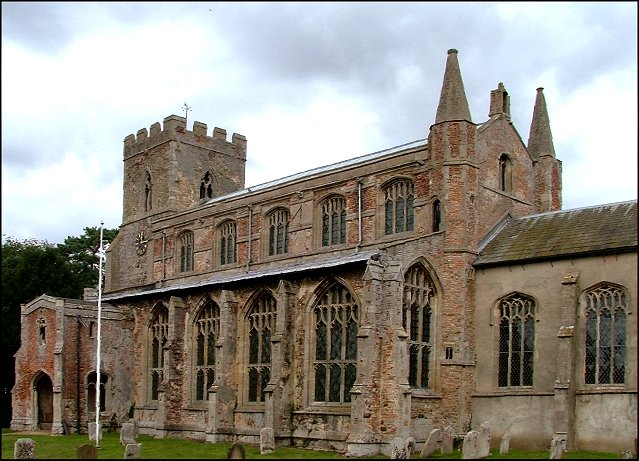| |
|
St Mary
Magdalene, Magdalen
 |
|
You
cross the wide, lazy Great Ouse, and at once
Norfolk changes. The rippling countryside
flattens out, the horizon straightens. Norfolk's
trees disappear, apart from the odd one or two
that flame like beacons below the perpendicular
sky. There aren't really fields anymore, just
wide prairies, and the villages are perfunctory.
This is the Marshland. Pevsner
mentions very few buildings west of the Ouse -
except the great churches, some of which are
among England's finest. In his book England's
Thousand Best Churches, Simon Jenkins
includes no less than ten of the Norfolk
marshland churches. There are only nine for the
whole of Northumberland.
Magdalen
is perhaps close enough to the rest of Norfolk to
still be a proper East Anglian village, and a
pretty one at that. One to savour if you are
heading west and about to tip off the edge of the
real county into that strange, sinking landscape
beyond. Inexorably, water spilt here would roll
into Lincolnshire. But the church is a marshland
church, big bold and beautiful with that air of chiarascuro
familiar from its neighbours, a slightly
decayed beauty with the smell of old wood and
damp in the air.
|
The
village takes its name from St Mary of Magdala, of
course, because it is really one of the Wiggenhalls. Over
the years, Wiggenhall St Mary Magdalene has become a bit
of a mouthful, particularly given the presence of the
nearby parish of Wiggenhall St Mary, where there is no
real village. So, Magdalen it has become, incidentally
giving its name for a time to the railway station on the
Cambridge to Kings Lynn line nearby, although that has
returned to its original name of Watlington now. The
church is a gorgeous assemblage of red brick, flint and
stone, wholly organic as it rises venerably in the narrow
graveyard.
It is all
pretty much 15th century, built on wool money, although
as is common in East Anglia the great tower is earlier,
on the eve of the Black Death. If it had ever been
rebuilt, this would have been one of the most magnificent
churches in England.
You step
into a huge building, full of light, a dusty air falling
slowly. At the west end, there is a strange little door
into the base of the tower, and I wonder if the
rebuilding of the nave raised the level of the floor. On
either side of it the remains of the rood screen are
propped up, just four panels depicting the evangelistic
symbols. Now, this is very curious, because the
evangelistic symbols do not generally appear on
roodscreens. But the work certainly looks medieval, and
the face of Matthew's winged man has been scratched out.
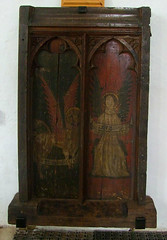   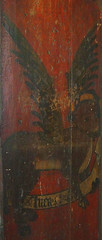 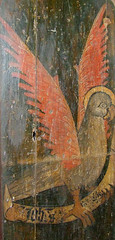 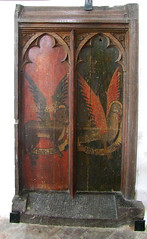
Much of
the character of the nave comes from the woodwork, a
pleasing mixture of simple medieval benches and 19th
century box pews beneath the original 15th century roof,
which is rather rustic in character with alternating
hammerbeams and queen posts.
Just as
neighbouring Wiggenhall St Mary has the largest
collection of medieval bench ends in Norfolk, St Mary
Magdalen has the largest collection of 15th century
stained glass figures. There are about forty of them,
scattered in the upper lights of the north aisle.
However, they are a rather specialist collection, and not
easily identifiable to the untutored eye, because rather
than familiar Apostles and Saints they mostly represent
Bishops, Archbishops and Popes.
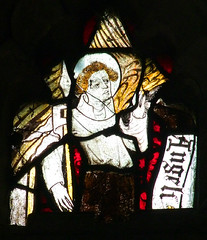 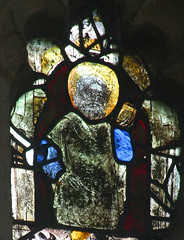 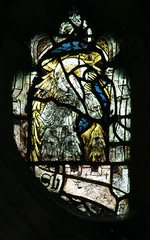 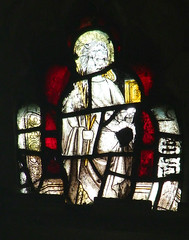
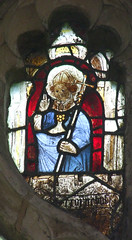   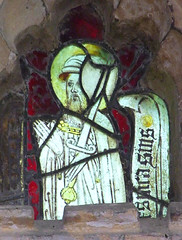
| Simon
Cotton, in the church guide, provides an
excellent key to them. Ann Eljenholm Nichols'
book Early Art of Norfolk, probably the
best book ever written about the medieval
churches of Norfolk, shows that more than a few
of them are unique representations in the county,
and perhaps in the Kingdom. Most of them have
scrolls, and with binoculars you can decipher
some of the inscriptions, but few have their
familiar symbols with them. An
exception is the coy St Helen in the east window
of the aisle. The glass in this window appears to
be by a different hand, and may have been
collected from elsewhere. There is one earlier
figure, a 14th century Bishop who may well be St
Nicholas, in the lower part of the middle window.
This
is a pleasant building to wander in, and big
enough to give a sense of exploration to a
browse. The chancel arch is immense, and this is
accentuated somewhat by the lack of a tower arch
at the other end. The stone floors are pleasing
and set off the old woodwork well. Above,
wingless angels hold symbols of the Passion.
Below the capitals of the arcade, enormous ugly
heaters, as attentive as triffids, look on. A
church full of atmosphere, then.
|
|
 |
Simon Knott, June 2006, updated April
2017
|
|
|

